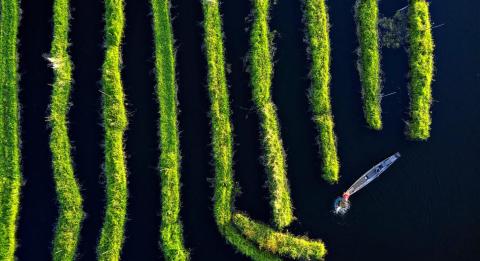ASEAN: Inspiring action for wetlands restoration
Message from Dr. Theresa Mundita Lim
Executive Director, ASEAN Centre for Biodiversity
2 February 2023 -- Today, the ASEAN Centre for Biodiversity (ACB) joins the international community in celebrating World Wetlands Day (WWD) to call for collective actions to restore this vital ecosystem.
With the theme, “It’s time for wetlands restoration,” this year’s WWD calls upon governments, international organisations, and other key sectors around the globe to include the conservation and restoration of wetlands in their priorities given its rapid decline.
Why we need to act NOW
According to the Ramsar Convention, wetlands are defined as areas of marsh, peatland, or water, whether they are natural or man-made, long-term or short-term, with water that is still or flowing, fresh, brackish, or salt, including areas of marine water whose depth at low tide does not exceed six meters, and as such, cover important inland and coastal/nearshore ecosystems. Wetlands provide us with immense benefits that are crucial for survival. Aside from its role as natural water reservoirs, wetlands serve as barriers against strong winds, heavy rain, and rising sea levels. Wetlands are essential habitats for a variety of numerous types of fish, animals, birds, insects, shellfish, and amphibians. They also serve as abundant sources of food and breeding sites for migratory waterbirds.
However, according to the Global Wetland Outlook, we are losing wetlands “three times faster than forests,” with an estimated 35% of loss since the 1970s. If we look back to our world’s wetlands in the 1700s and its current state, almost 90% have already been degraded or lost.
Wetland conservation and restoration efforts in the ASEAN
Almost 2 million square kilometers of lakes, rivers, freshwater swamps, marshes, streams, and other inland waters and wetlands can be found in the ASEAN region. Out of the region’s 55 ASEAN Heritage Parks (AHP), 9 are wetlands, occupying approximately 684,000 hectares. AHPs are protected areas in the region that were recognised for their biological and ecosystem diversity and effective protected area management practices. Most of these parks were also recognised as Ramsar sites, or wetlands of high international importance.
Through the AHP Programme, the ACB supports wetland protected areas in the region by providing support and opportunities for capacity enhancement in protected area management, livelihood development, and law enforcement. The programme also opens possibilities for financial support from the Centre’s conservation partners.
Meinmahla Kyun Wildlife Sanctuary (MKWS), an AHP in Myanmar, increased stakeholder understanding of the new law on protected area zonation and regulation, based on the management plan and the environmental and economic significance of MKWS mangrove and mudflats. Mangrove restoration initiatives have also been formed as a source of income for the local communities in the area. This was made possible by a joint initiative of ASEAN and Germany through the KfW called the ACB Small Grants Programme (SGP).
Another wetland AHP in Myanmar, the Indawgyi Lake Wildlife Sanctuary, seeks to enhance its management planning, law enforcement, and environmental awareness initiatives. Through the SGP, a cooperative management plan was created, illicit fisheries were reduced, significant portions of a wildlife sanctuary and management zones were formed, and support was given to a community-based information network to gather data for better law enforcement operations.
Additionally, with the assistance of the Biodiversity Conservation and Management of Protected Areas in ASEAN (BCAMP) Project of the ACB, Viet Nam implemented protected area action plans on the quick assessment of wetland ecosystem services in two of its Ramsar sites.
Meanwhile, the Agusan Marsh Wildlife Sanctuary, a wetland AHP and a potential flyway site in the Philippines, was provided with policy, planning, sector engagement, financial, and capacity enhancement support for waterbird census and wetland assessment survey by the ASEAN-EU Sustainable Management of Peatland Forests. This was supported by the first phase of the project Improving Biodiversity Conservation of Wetlands and Migratory Waterbirds in the ASEAN Region.
Studies show that by 2050, almost 70% of the world’s total population will settle in cities and urban areas. Hence, the ASEAN also intends to revisit the AHP’s existing criteria to be able to include more urban wetlands in the network of AHPs to boost the conservation of this critical ecosystem.
To further encourage the restoration of degraded inland waters and wetlands, the ASEAN launched the ASEAN Green Initiative, a recognition scheme for outstanding ecosystem restoration initiatives in the ASEAN region. The AGI aims to establish benchmarks for the recognition of best ecosystem restoration activities that not only regenerate our forests but also improve people’s well-being, livelihoods, and resilience. This is in line with the actions that the ASEAN Member States are taking to regenerate our environment. In line with the UN Decade on Ecosystem Restoration, the ASEAN aims to encourage the planting of at least 10 million native trees across 10 AMS over the course of 10 years.
This year, Indonesia takes on the ASEAN chairship with the overarching theme, ASEAN Matters: Epicentrum of Growth. The ACB stands ready to support Indonesia in making the region more capable of responding to global concerns including climate change, species extinction, and habitat degradation for a sustainable and resilient future—and in realising this goal, wetlands certainly matter.
Happy World Wetlands Day!

